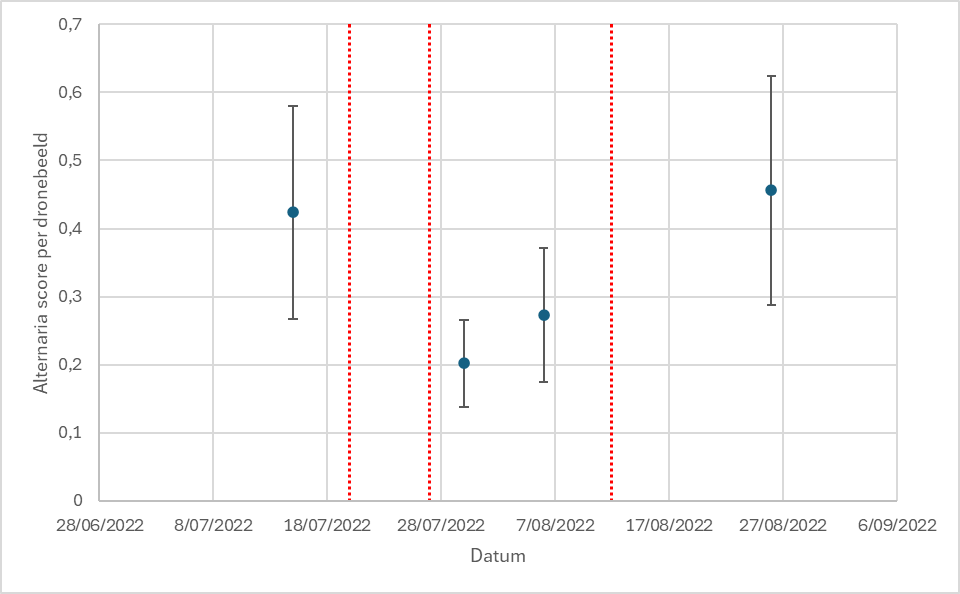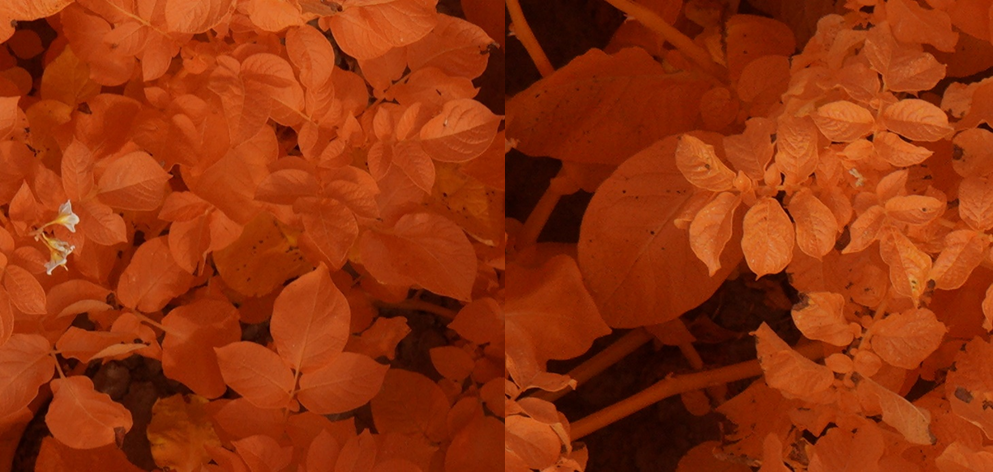General High-flying innovation: Alternaria detection using drones and AI
Potato is a typical crop of Flemish agriculture. Its cultivation constitutes one of the most important parts of the Belgian agricultural economy. In 2022, 3.6 million tons of potatoes were produced, of which about 2 million tons were produced in Flanders. These figures place Belgium among the top five largest producers of potatoes in the EU.
However, the crop needs to be treated with plant protection products very often. As a result, the sector faces significant challenges that are complex and diverse. Maintaining sufficient quality and quantity, dealing with resistant diseases and pests, ensuring traceability, ensuring food safety and complying with legislation around existing resources are crucial elements that require constant attention. By investing in technology, sustainable practices, and robust legal compliance, companies can not only meet these challenges, but also gain and maintain consumer trust.
These challenges also drive ILVO to conduct research within this crop with innovative techniques. Through previous and ongoing research, in close cooperation with the universities KU Leuven and UGent, ILVO succeeded in developing a drones-based monitoring system for early detection of the fungal disease Alternaria solani.
Alternaria solani is the second most devastating foliar pathogen of potato crops worldwide. It causes early leaf disease and premature leaf loss of the plants and thus also has a negative impact on production. Currently, therefore, preventive, presymptomatic and full-field use of plant protection products is used to prevent the infections.
In the doctoral studies of Ruben Van De Vijver (Van De Vijver et al., 2022) and Jana Wieme (Wieme et al., 2022; 2024) camera technology and artificial intelligence were used to detect symptoms of disease at an early stage (3 to 5 days after infection).
For this, a modified RGB camera was used in which the addition of a near-infrared band (part of the electromagnetic spectrum not detectable by the human eye) provides a contrast enhancement between healthy and damaged parts of the leaf (Figure 1). Very high resolution images of 0.3 mm per pixel allow the spots to be clearly perceived in the images. By taking into account where and when symptoms are present, one can limit the use of plant protection products to the areas and times when they are really needed.

Figure 1: Difference between photo taken by a traditional red-green-blue (RGB) camera (top) that displays the colours perceptible to the eye and a modified image (bottom) in which the red colours are replaced by a near-infrared band. This makes the spots on the leaves, caused by the damage by Alternaria solani, more quickly and clearly visible. The images were taken at the same time and in the plot (Van De Vijver et al., 2022).
In Jana Wieme's study (Wieme et al., 2024), drone images were taken with the modified camera over different fields and years (2019, 2020, 2021, 2022) to include different potato varieties, growth stages, differences in exposure and weather conditions in model training (Figure 2). This resulted in 14,057 labelled patches (of which 6,148 patches labelled as "Alternaria"). A model she developed was compared with 5 state-of-the-art deep learning models and achieved similar accuracies. Her model had the advantage that it could be trained faster and required less computing power, making it useful for application.

Figure 2: Representation of the full workflow of data collection, model training (left) and model inference and application (right) (Wieme et al., 2024).
Her results are very hopeful of using these deep learning algorithms to create task maps for variable spray applications. The model was only applied to fields in an experimental setting, though. Alternaria disease was artificially introduced into a few zones in the field. Outside these zones, no disease was present. This differs from the natural spread of such a disease in the field. As an additional test, a potato plot at ILVO was monitored over a growing season during which Alternaria was allowed to spread naturally. This included weather data to definitely collect data before and after favourable conditions for infections (Figure 3). The plot did have an artificial weed pressure constructed to demonstrate the Smart AgriHubs (SAH) demonstration event of 2022, but this seems to have no effect on Alternaria distribution.

Figure 3: Weather data throughout the growing season. The highest risk for Alternaria infections is on hot, humid days.
Four different flights were conducted on the plot. We observed that the predicted mean score per drone image in the first flight (on 17/07/2022) was higher than in the two subsequent flights (Figure 4). This is due to Alternaria infections, which are mainly located in the lower (and older) leaves of the crop (Figure 5).

Figure 4: Average Alternaria score per drone image, predicted by the deep learning model, for four different flight times. The error bars give the standard deviation of this predicted score per flight. The vertical dotted line represents the three times (July 20, July 27 and August 12) when the field was treated against Alternaria.

Figure 5: Two images from the 17/07/2022 flight. A clear disease sign of Alternaria are clustered lesions (spots of dead leaf tissue) that occur more centrally in the leaves. In this case, mainly in the lower leaves of the crop. Larger spots may appear as these lesions expand. If they occur at the tips of the leaves, this disease picture closely resembles other leaf diseases (e.g. Verticillium and Phytophtora), desiccation symptoms and natural decomposition of the foliage.
As new, higher located, healthier leaves develop, the spots are shielded in the drone images and the average score (Figure 6) decreased in the succeeding flights (29/07/2022 and 05/08/2022).
The summer of 2022 was one of the hottest summers in Flanders (and Europe). With 38.1°C, July 19 was the 2nd warmest day since observations began. It was also relatively dry, with days of light precipitation on July 20, July 21 and August 18 and precipitation on August 17. These conditions were not ideal for the further spread of Alternaria in the crop, which spreads best with sufficient leaf moisture (after rain or dew formation) combined with warm days and relative humidity higher than 85%. In addition, the plot had also been treated twice with fungicides before these flights (on July 20 and 27).

Figure 6: Two images of the 29/07/2022 flight (top) and 05/08/2022 (bottom). New, healthy leaves developed above the infected leaves, reducing the predicted mean Alternaria score compared to the 14/07/2022 flight.
Then again, in the last flight (25/08/2022), the predicted mean score had risen sharply. Based on the drone images, we see that large, black spots have developed, mainly at the tips of the leaves (Figure 7). This may be partly caused by Alternaria, but also by heat and drought stress, or by the natural dying off of foliage at the end of the growing season.

Figure 7: Two images of flight 25/5/2022. Large, black spots are reflected in the leaves (mainly at the edges).
Conclusion: the models can already be used as an early warning system, especially when combined with expert knowledge of cultivation and disease. Nevertheless, we continue to do further research to improve this and other disease detection models by looking for typical characteristics of Alternaria and other diseases, stressors and natural leaf breakdown, and then feeding this information to the models.
The predicted values for each drone flight are available as an interpolated raster layer (Figure 8) as a demonstration dataset for the participants of the VLAIO Coock OpsDrone project. If you are also interested in this dataset and other presentations, datasets and project results, you can register for the OpsDrone project for free here.

Figure 8: Predicted Alternaria value per drone image. One orthophotomosaic of the field in a plain colour image was created as a background map.
More interested in this topic? Then also check out these posts (in Dutch):
Alternaria detectie in aardappelen met dronebeelden
Terugblik op een geslaagde inspiratieworkshop rond drone-diensten in de landbouw


